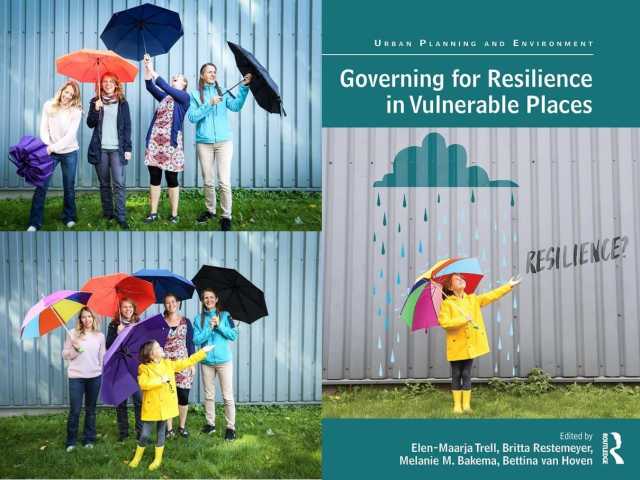“Governing for Resilience in Vulnerable Places”*: a new book by Elen-Maarja Trell, Britta Restemeyer, Melanie Bakema, Bettina van Hoven
| Date: | 06 October 2017 |
| Author: | Elen-Maarja Trell, Britta Restemeyer, Melanie M. Bakema, Bettina van Hoven |

In the past decades the term ‘resilience’ has quickly gained currency in academia (including social, political and spatial sciences) as well as in practice. Nowadays, it is widely promoted as a promising concept to deal with shocks and uncertainties in the face of environmental, social and economic crises (cf. Davoudi, 2012; White, 2010). Originating in ecology, resilience was referred to as the ability of a system to return to stability or equilibrium after a disturbance (Pickett et al., 2004). According to an early formulation by Holling (1973), resilience indicates the ability of ecosystems to absorb changes and still be able to function properly. In the past decade a so-called ‘resilience turn’ (Evans & Reid, 2014) has taken place in the social, political and spatial sciences where social-ecological resilience has been explored and applied as a useful concept to describe and organize responses to change by communities, institutions and economies (Adger, 2000; Klein et al., 2004; White, 2010). In spatial planning, for example, resilience is now widely acknowledged as a new approach to incorporate uncertainty into governance strategies, in particular with respect to natural hazards such as flooding (Davoudi, 2012; White, 2010).
Translating and applying the concept of resilience from its ecological and engineering roots to social sciences, however, remains a challenge. It is not surprising then that, due to the ambiguity of the concept ‘resilience’, research has largely focused on exploring the meaning of the concept (cf. Pendall et al., 2010; Davoudi, 2012; Alexander, 2013). However, there remains ‘an apparent gap between the advocacy of socio-ecological resilience in the scientific literature and its take-up as a policy discourse on the one hand, and the demonstrated capacity to govern for resilience in practice on the other’ (Wilkinson, 2012, p. 319). Current practices show that resilience is often used as a panacea to different problems (O’Hare & White, 2013). In some cases ‘resilience’ might simply be a means to redress a problem and to justify an outdated or inherently unjust policy. In other cases resilience may be so vague and far removed from its meaning that a so called ‘resilience approach’ may lead to less desirable, not nearly resilient, outcomes (Van der Vaart et al., 2015). The term ‘resilience’ therefore runs the risk of becoming a heavily contested buzzword.
As a result, there is a need for a better understanding of the potential and the challenges connected to the use of the concept of resilience in social sciences today. While an increasing number of books on resilience has been published in the past decade, the bulk of the books has focused on rather specific topics such as disasters (Comfort et al., 2010; Lansford et al., 2012; Hicks Masterson et al., 2014; Tidball et al., 2014; Tierney, 2014), climate change (Pelling, 2003; 2011), water (White, 2010), or on one distinct spatial context such as the city (Beatley & Newman, 2008; Beatley, 2009; Wamsler, 2009; Eraydin & Tasan-Kok, 2012; Rogers, 2012; Pearson et al., 2014) and to some extent the rural regions (Brown & Schafft, 2011; Tamásy & Diez, 2013)[i]. The edited book ‘Governing for Resilience in Vulnerable Places’, however, draws together state of the art research from across a variety of social science disciplines (i.e. spatial planning, economic and cultural geography, environmental and political sciences, sociology and architecture) and across different spatial and geographical contexts (from urban slums in India to flood-prone smaller communities in the UK to coastal Japan). By doing so, the book is able to provide an overview and a critical analysis of the ways in which the concept ‘resilience’ has been ‘translated’ into and used in social and spatial sciences today. Acknowledging that resilience is a new powerful lens through which researchers and practitioners assess, discuss and make plans for major matters, special attention is paid to ethical, social and political issues at stake when trying to operationalize and use the concept of resilience in practice. As such, ‘Governing for Resilience in Vulnerable Places’ is aimed to provide a scientifically robust overview and generate some conceptual clarity for researchers, students as well as practitioners interested in the potential of resilience thinking as well as the application of resilience in practice.
* The above text is an excerpt from the introductory chapter of the book “Governing for Resilience in Vulnerable Places” (Routledge, 2017). For more information see: https://www.crcpress.com/Governing-for-Resilience-in-Vulnerable-Places/Trell-Restemeyer-Bakema-Hoven/p/book/9781138216495
[i] Exceptions include the book by Evans & Reid (2014) providing critique on the concept of resilience and exploring the political and philosophical stakes of the ‘resilience turn‘, the work by Zolli & Healy (2012) discussing the concept of resilience and the bouncing back abilities of systems, people and places; exploration of spatial resilience by Cumming (2011) and the book by Walker and Salt (2006) offering a conceptual overview of resilience thinking.

